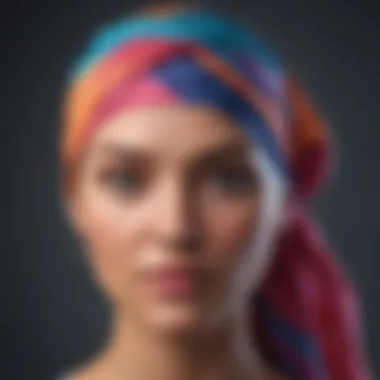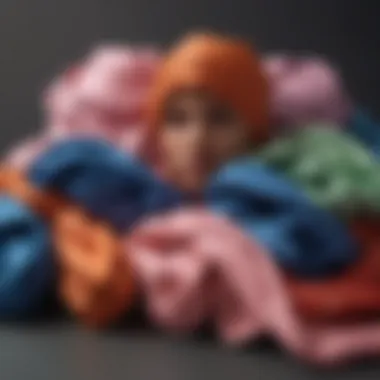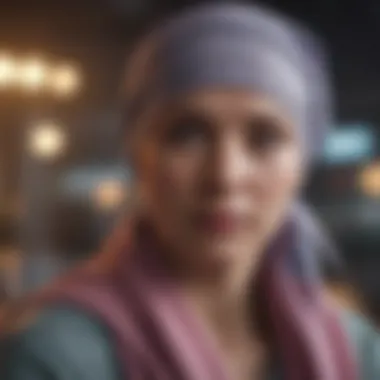The Importance of Do Rags for Cancer Patients


Intro
The journey through cancer treatment can be arduous, both physically and emotionally. Among the myriad of challenges faced by patients, the loss of hair is often one of the most visible and distressing. This experience can lead to feelings of vulnerability and loss of identity. Do rags, simple pieces of fabric tied around the head, emerge as more than just a fashion statement; they serve important functions that can significantly impact the well-being of cancer patients.
This article aims to explore the role of do rags in the cancer care journey. We will examine their design, functionality, and cultural relevance, offering insight into how they help patients cope during this challenging time. Through the inclusion of testimonials and insights from health professionals, this piece highlights the therapeutic benefits of do rags, providing a comprehensive understanding of their significance in a cancer patient's life.
Foreword to Do Rags in Cancer Care
The conversation surrounding do rags in cancer care is essential. These accessories serve not only a practical purpose but also provide emotional and psychological support for patients experiencing hair loss due to cancer treatment. Understanding their significance requires a closer look at the multifaceted role they play in patients' lives. The presence of hair contributes to a sense of identity and self-esteem, which can be significantly impacted during cancer treatment. Many individuals turn to do rags as a way to navigate these changes gracefully.
Understanding Hair Loss in Cancer Patients
Hair loss in cancer patients often results from chemotherapy or radiation therapy. This process can be distressing, as hair does not just hold physical beauty; it carries emotional weight and personal identity. Patients may feel less like themselves when they lose their hair. They might experience feelings of vulnerability and exposure, transforming their interactions with the world. Do rags can offer a comforting solution, providing warmth and covering that diminishes the stark visual reminder of treatment. Additionally, feeling fashionable and put-together can enhance confidence, even in difficult times.
Purpose of Do Rags
The primary purposes of do rags for cancer patients can be summarized into several key areas:
- Protection and Comfort: Do rags can provide a barrier against harsh weather and maintain warmth, especially delicate scalps post-treatment.
- Fashion and Personal Expression: They allow individuals to express their style, even when undergoing significant physical changes.
- Psychological Support: Wearing a do rag can mitigate feelings of self-consciousness. It presents a way to embrace change while maintaining a sense of control over one's appearance.
- Social Connection: In various communities, do rags can symbolize solidarity and shared experiences among cancer patients, promoting a sense of belonging.
Historical Context of Do Rags
Understanding the historical context of do rags is crucial in exploring their relevance and significance for cancer patients. The evolution of these accessories reflects broader societal changes, including fashion trends, cultural movements, and practical needs that cater specifically to those experiencing hair loss due to medical conditions like cancer.
Evolving Fashion Trends
Do rags have oscillated through time, shifting from practical headwear to cultural symbols. Initially, they were largely utilitarian, created for individuals at work, especially in labor-intensive environments like construction sites and kitchens. Their simple design helped protect hair from dirt and grease while also absorbing sweat.
With the onset of the late 20th century, do rags started to permeate mainstream fashion. This shift was greatly influenced by hip-hop culture and artists who proudly showcased them as a form of self-expression and style. This broader acceptance transformed do rags into fashion statements, easily moving them from the workplace to social events and everyday wear.
The versatility inherent in do rags—combined with their functional advantages—allows for adaptations in both style and material. They became available in various designs, colors, and fabrics, catering to diverse preferences. The effective blend of style and function has contributed to the growing popularity among breast cancer patients, who may opt to wear them to cover hair loss after chemotherapy or as a statement of resilience.
Cultural Significance
In addition to their practicality and fashion aspects, do rags hold considerable cultural significance. They often symbolize pride, identity, and community connection, especially within certain demographics. Historically, they have been a part of African American culture. The do rag serves not just a utilitarian purpose, but also acts as a means of cultural expression and belonging.
For cancer patients, wearing a do rag can resonate deeply on a personal level. It is not uncommon for them to adopt the accessory as a symbol of their fight. It contributes to altering their image in a manner that aligns with their current journey. For many, a do rag can reclaim a sense of control over their appearance, something that can be lost during treatment. The cultural context enriches their significance, allowing individuals to express solidarity with their community while navigating the challenging landscape of cancer treatment.
**"Wearing a do rag helped me feel like I was taking charge of my situation, even when I felt powerless. It became more than just fabric; it was part of my identity."
These cultural significances and evolving fashion trends illustrate how do rags are not merely accessories; they are complex items laden with meaning, offering both support and style to cancer patients, allowing them to express resilience and individuality.
Design Features of Do Rags
Understanding the design features of do rags is crucial for recognizing their significance in the lives of cancer patients. These accessories serve not only practical purposes but also have aesthetic and psychological benefits. Different materials, styles, and their functionality play pivotal roles in how do rags are perceived and utilized by individuals undergoing treatment.
Material Choices


The choice of material in do rags is essential for several reasons. First, cancer patients often experience sensitive skin and scalp due to treatments like chemotherapy. Fabrics that are soft and breathable can minimize irritation and discomfort. Common materials include cotton, which is known for its softness, and satin, which is gentle on the skin and can help reduce friction.
Comfort is a primary factor; thus, an ideal do rag should feel pleasant against the skin. Cotton is absorbent and allows air circulation, while satin keeps the scalp cool. Another aspect worth noting is the elasticity of the fabric, which ensures that the do rag fits snugly without being overly tight, accommodating various head sizes.
Style Variations
Do rags come in numerous styles, each catering to different preferences and occasions. The versatility in design is particularly beneficial for cancer patients who may want to express their identity or maintain a sense of normalcy during treatment. Styles can range from simple solid colors to intricate patterns and prints that reflect personal style or cultural significance.
Wearing a do rag can also be a statement of resilience and comfort. Some patients may opt for brighter colors as a means of uplifting their spirits, while others might prefer more subdued tones that feel less conspicuous. The options enable patients to choose what resonates with them personally, which can be an important aspect of their healing journey.
Functionality and Comfort
Functionality of do rags encompasses several elements critical for supporting cancer patients. One of the primary functions is keeping hair in place, which can be crucial for those experiencing hair loss. Do rags can also be used to keep the head warm, especially in cases where patients feel cold due to the effects of chemotherapy.
Beyond practicality, the comfort factor should not be overlooked. A well-designed do rag will not only stay in place but also prevent unnecessary pressure points on the scalp. The combination of soft materials and thoughtful design translates to a product that can be worn throughout the day without causing discomfort. Some users even report that wearing a do rag helps them feel more in control of their appearance, providing a psychological boost during challenging times.
Finale
In sum, the design features of do rags—spanning material choices, style variations, and their functionality—play a significant role in the cancer care process. These elements are not merely aesthetic; they contribute to the overall comfort and well-being of patients. Therefore, understanding these features is a step towards recognizing the importance of do rags as both practical tools and symbols of identity for cancer patients.
Psychological Benefits of Wearing Do Rags
The psychological impact of cancer is profound, affecting not just the physical being but also the mental and emotional state of patients. Wearing do rags serves as a unique coping mechanism that can provide various psychological benefits. This section delves into how these accessories can enhance self-esteem and reduce stigma for those undergoing treatment.
Enhancing Self-Esteem
For many cancer patients, hair loss during treatment can lead to diminished self-worth and altered body image. Do rags can play a significant role in restoring a sense of normalcy and identity. By providing an opportunity for personal expression, wearing a do rag allows patients to feel a connection to their former selves or even explore new identities. The choice of color, pattern, and style can serve as a form of self-expression, helping to instill confidence.
Furthermore, the act of choosing and wearing do rags can contribute to a positive self-image. The daily routine of tying on a do rag can bring a sense of control back into a patient's life. This ritualistic behavior can foster motivation and enhance mood. When patients find comfort in their appearance, it can lead to a more optimistic outlook on their treatment journey.
Reducing Stigma
Stigma surrounding cancer and its visible effects often leaves patients feeling alienated. Do rags can act as a bridge, helping to mitigate this stigma by creating a space for dialogue about cancer. Wearing a do rag not only signifies solidarity with one's own journey but also invites conversation and inquiry from others. It can transform a symbol of vulnerability into one of strength.
"The simple act of wearing a do rag allows many patients to communicate their resilience and fight against preconceived notions about appearance."
In this way, do rags can foster an environment of acceptance. They allow cancer patients to share their journey with others, making it easier to confront negative perceptions. As communities become more familiar with the choices individuals make in their healing process, the stigma attached to cancer can diminish.
In summary, do rags have substantial psychological benefits for cancer patients. By enhancing self-esteem and reducing stigma, these accessories can be a vital aspect of a patient's cancer care journey.
Community Initiatives Surrounding Do Rags
Community initiatives that focus on do rags play a significant role in providing support and solidarity to cancer patients. These efforts often create a sense of belonging while addressing practical and emotional needs. For many patients, engaging in these initiatives offers a platform to share experiences and build networks that foster resilience. The communal aspect of such programs becomes vital, as it connects individuals navigating similar challenges.
Support Groups and Networks
Support groups dedicated to cancer patients often include discussions about the role of do rags in their lives. These gatherings allow participants to share personal stories, which can enhance understanding and empathy among group members.
The inclusion of do rags in such support systems can help in promoting emotional well-being. Patients find common ground with others who have experienced hair loss due to treatment. It also helps in normalizing the discussions around the physical changes brought on by cancer.


Additionally, these groups may organize sewing circles. Here, volunteers sew do rags to provide them free to patients. This not only fulfills a practical need but fosters creativity and self-expression among group members. The action of sewing can be therapeutic, allowing participants to channel their feelings into a productive effort. The communal effort behind making do rags enhances their value, making them symbols of solidarity and support.
Fundraising and Awareness Campaigns
Fundraising efforts centered on do rags have gained momentum in recent years. These campaigns are crucial in raising awareness about the practical needs of cancer patients, especially those experiencing hair loss.
Organizations host events, such as charity runs or fashion shows, with proceeds directed toward providing do rags. Such initiatives help in eliminating the stigma often associated with cancer by encouraging open discussions and visibility. Funds raised can also support additional resources for patients, such as counseling or financial assistance.
Awareness campaigns that highlight the benefits of do rags serve to educate the public. These initiatives often leverage social media to spread their message. Platforms like Facebook and Reddit have become pivotal in mobilizing communities. They allow individuals to share stories, experiences, and photographs while promoting both fundraising events and the importance of do rags in cancer care.
Through these community efforts, individuals not only receive tangible goods like do rags but also emotional support that is essential for their healing journey. Together, these initiatives build a robust safety net for cancer patients, reinforcing the message that they are not alone in facing their challenges.
Testimonials from Cancer Survivors
Testimonials from cancer survivors provide essential insights into the personal experiences surrounding do rags. These narratives not only highlight the individual journeys through illness and recovery but also showcase the emotional and social effects of wearing do rags. Survivors often share how do rags became a symbol of their strength and resilience, offering a sense of normalcy during challenging times. Their stories can impact others by offering hope and encouragement. Such testimonials illustrate the myriad of ways do rags adapt to individual needs and preferences, showing that they are not merely fashion items, but rather tools for empowerment within the cancer community.
Impact on Daily Life
For many cancer patients, daily life can feel disrupted by the physical and emotional toll of their illness. Hair loss is a prominent side effect of certain treatments, leading to feelings of vulnerability. Survivors often discuss how do rags provided them with both comfort and practicality in their daily routines.
- Comfort: Wearing a do rag can help keep the head warm, especially in colder environments. For some, it feels softer on the scalp compared to other headwear.
- Protection: Do rags can shield the sensitive scalp from sun exposure, which is particularly critical for those undergoing treatment.
- Convenience: Many find do rags easy to wear, as they require minimal effort to style. This simplicity can ease the pressure of daily grooming.
Through these practical benefits, cancer survivors express how do rags became a part of their coping mechanisms, allowing them to navigate their daily life with greater ease. Moreover, the choice to wear a do rag often affirms a sense of control over their appearance, a small but significant element to promote a positive mindset.
Reflections on Identity and Style
The intersection of style and identity is profound in the context of cancer survivorship. Survivors often share that do rags allowed them to express their personal style, even amidst the significant changes brought by their illness.
- Cultural Identity: For some, do rags are reflective of cultural heritage or personal beliefs. They may choose specific patterns or colors that resonate with their identity.
- Empowerment through Choice: Selecting a do rag design that feels right can boost confidence and help reclaim a sense of self. It gives patients a choice in how they present themselves to the world.
- Community Connection: Wearing a do rag can create bonds with others who resonate with the same experiences. This connection helps create a supportive network based on shared understanding and empathy.
Survivors often share how these expressions of identity help mitigate feelings of stigma associated with hair loss. By narrating their choices, they encourage others to view do rags not only as an accessory but as a statement of individuality and strength.
"Wearing a do rag transformed how I viewed myself. It was more than just a scarf; it was a way to show who I was, even when my hair was gone."
Do Rags and Medical Professionals
The role of do rags in the context of cancer care extends beyond mere aesthetics and touches on crucial interactions with medical professionals. Understanding the perspective of oncologists and counselors in this realm can provide insight into the significance of do rags for patients undergoing treatment.
Perspectives from Oncologists
Oncologists see firsthand the physical and emotional challenges cancer patients face, one of which is hair loss. This loss can greatly affect a patient’s self-image and mental health. Do rags serve a dual purpose here: they offer protection for the scalp and can significantly boost a patient’s confidence.
Many oncologists recommend do rags, particularly in the early stages of treatment when patients might be most vulnerable. They highlight that wearing do rags can create a sense of normalcy and empowerment. In addition, these accessories can also provide practical benefits by covering sensitive areas, shielding patients from sun exposure, and providing warmth in colder conditions.
Furthermore, some studies suggest that feeling good in one’s appearance can positively influence treatment outcomes. Overall, oncologists recognize the therapeutic potential of do rags, advising patients on styles and materials that best suit their needs.
Counseling Insights on Acceptance


Counselors play a vital role in supporting cancer patients through their emotional journey. Acceptance of changes in appearance, particularly hair loss, is often a significant hurdle. Do rags can help facilitate this acceptance. Counselors note that integrating do rags into a patient’s routine can serve as a powerful tool for self-expression.
Patients can choose do rags that reflect their personality, thus reclaiming some control over their appearance. This act of choosing can be quite empowering. It also opens up discussions about body image and identity. In many cases, counselors find that discussing the use of do rags allows patients to explore their feelings about hair loss more freely and helps them realize that their self-worth is not tied to their physical appearance.
"Wearing do rags can symbolize a fight against cancer, representing strength and resilience in the face of adversity."
Through this lens, the importance of do rags becomes clear. They are not just an accessory, but rather a means for patients to express themselves and navigate their healing journeys with dignity.
Future Trends in Do Rags for Cancer Patients
The landscape surrounding do rags for cancer patients is evolving. As awareness of the therapeutic and social benefits of these accessories increases, so do the prospects for their future. Understanding these trends is crucial for patients, caregivers, and advocates alike.
Innovations in Design
Innovation in design focuses on functionality as well as aesthetics. New materials are being introduced that enhance comfort and breathability. Natural fabrics, such as cotton and bamboo, are gaining popularity for their softness and ability to manage moisture. These materials not only provide comfort but also reduce the risk of skin irritation, which can be common among cancer patients.
Customizable designs have emerged, allowing patients to select colors and patterns that suit their personal style. This development promotes a sense of individuality and autonomy, which is essential during treatment. Additionally, features like adjustable straps or elastic bands improve the fit, enhancing comfort further.
Incorporating technology into fabrics is another area gaining traction. Some designs now include features such as UV protection or temperature regulation, providing additional layers of protection and comfort. The integration of these elements helps to make do rags more than just a simple accessory; they become multifunctional tools that meet the specific needs of cancer patients.
"Do rags are not just about style; they are adapted to the practical needs of patients, enhancing their daily experience while undergoing treatment."
Potential for Broader Adoption
The potential for broader adoption of do rags among cancer patients is significant. As communities and healthcare systems recognize their value, there is a shift in how these items are perceived. Educational campaigns can help dismantle stigma and promote acceptance. This move is essential for fostering an inclusive environment where all patients feel supported and empowered.
Medical professionals are increasingly acknowledging the role of do rags in cancer care. Their endorsement can lead to greater distribution in hospitals and clinics. Support groups can also play a part by providing do rags as part of care packages, helping to normalize their use.
Moreover, online platforms and social media are instrumental in sharing resources and information about do rags. Discussions on forums like Reddit can raise awareness and assist patients in finding suitable options. These digital spaces can help connect patients, caregivers, and advocates, further encouraging the adoption of do rags as a mainstream accessory.
In summary, as innovation in design prevails and societal attitudes shift, do rags have the potential to become an integral part of cancer care, providing both comfort and style in what can be a challenging journey.
The End: The Path Forward
The significance of do rags in the context of cancer care cannot be overstated. They offer more than just a solution to hair loss; they represent a powerful tool for empowerment and expression. As cancer patients navigate the complex journey of treatment, their emotional and psychological well-being remains paramount. Do rags play a role in enhancing confidence and promoting a sense of normalcy during an otherwise challenging time. They bridge the gap between medical necessity and personal identity.
Looking ahead, the focus must remain on encouraging inclusivity and acceptance. This means fostering a broader understanding of how do rags can aid in the emotional recovery of patients. Medical professionals, family members, and friends all share a responsibility to validate patients' choices regarding head coverings. They should support not just the practical benefits but also the aesthetic and emotional aspects of wearing a do rag.
Furthermore, as fashion evolves, so does the design of do rags. Innovations in fabric, style, and comfort are becoming essential. The future of do rags can lead to a wider range of options that cater to individual preferences, ultimately promoting self-expression while preserving a dignified appearance. Acknowledging the diversity in patient needs will be crucial to make do rags a staple in cancer care.
"Integrating do rags into cancer treatment plans not only supports physical comfort but also enhances emotional resilience, vital for the healing journey."
Communities must also embrace these changes. Local support networks and online platforms, such as reddit.com, can play vital roles in spreading awareness about the importance of do rags. Sharing stories of survival and resilience, patients can inspire each other and foster a sense of solidarity. This collective effort amplifies the message that when it comes to cancer care, every small accessory can have a monumental impact on personal well-being.
Encouraging Inclusivity and Acceptance
In encouraging inclusivity, it is vital to dismantle the stereotypes surrounding head coverings. Do rags often face misconceptions, labeled as purely functional or merely a fashion statement. Yet, they exist at the intersection of both. By promoting understanding of their significance, we enable a culture that respects personal choices while acknowledging the multifaceted reasons behind wearing a do rag.
Training in sensitivity and awareness for healthcare providers can further support this endeavor. Encouraging discussions about personal expression can create a more welcoming environment for cancer patients. Changes can happen at institutional levels, where clinics could provide information on the benefits of do rags and even host workshops on different styles and uses.
Final Thoughts on Do Rags in Cancer Care
As we synthesize the information discussed, it becomes clear that do rags serve as a crucial aspect of cancer care. They embody comfort, acceptance, and identity during a difficult chapter in life. Understanding their purpose and promoting their use can lead to improved self-esteem and mental well-being for cancer patients.
The dialogue surrounding do rags should continue beyond the medical space and into communities. By advocating for holistic care that includes psychological, social, and emotional support, we can drive awareness and foster environments where all cancer patients feel accepted and valued. No doubt, the simple act of wearing a do rag carries deeper connections to bravery and resilience, allowing cancer patients to reclaim agency over their appearance amid uncertainty.







